jump start Oldsmobile Aurora 1998 Owner's Manuals
[x] Cancel search | Manufacturer: OLDSMOBILE, Model Year: 1998, Model line: Aurora, Model: Oldsmobile Aurora 1998Pages: 380, PDF Size: 19.75 MB
Page 185 of 380
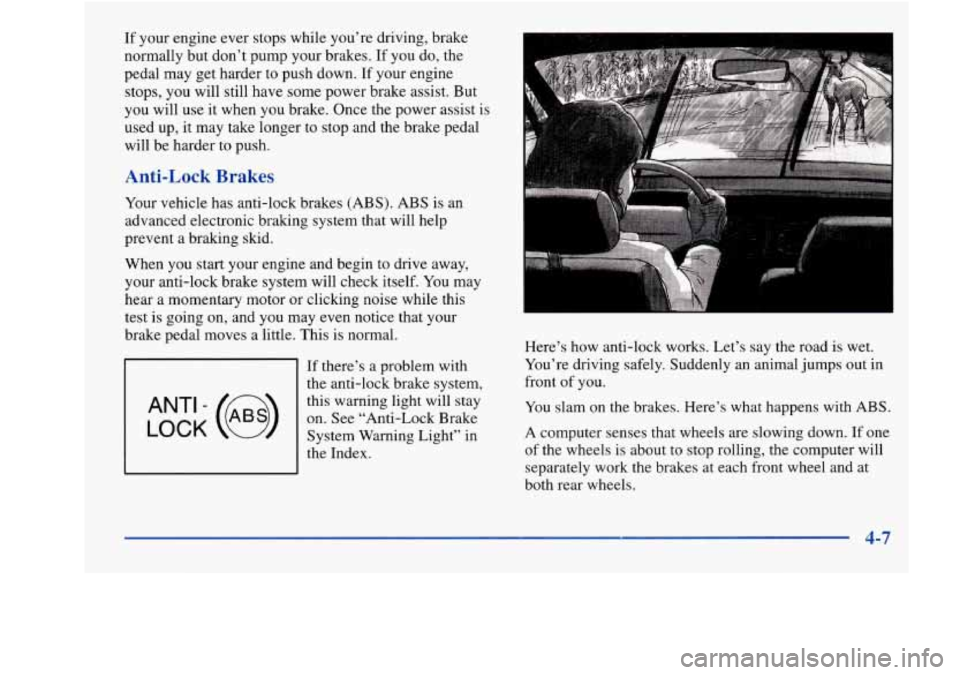
If your engine ever stops while you’re driving, brake
normally but don’t pump your brakes. If you do, the
pedal may get harder to push down. If your engine
stops, you will still have some power brake assist. But
you will use
it when you brake. Once the power assist is
used up, it may take longer to stop and the brake pedal
will be harder to push.
Anti-Lock Brakes
Your vehicle has anti-lock brakes (ABS). ABS is an
advanced electronic braking system that will help
prevent a braking skid.
When you start your engine and begin to drive away,
your anti-lock brake system will check itself. You may
hear a momentary motor or clicking noise while this
test is going on, and you may even notice that your
brake pedal moves a little. This
is normal.
If there’s a problem with
the anti-lock brake system,
this warning light will stay
System Warning Light” in
the Index.
LOCK
ANT‘- (@) on. See “Anti-Lock Brake Here’s
how anti-lock works. Let’s say the road
is wet.
You’re driving safely. Suddenly an animal jumps out in
front
of you.
You slam on the brakes. Here’s what happens with ABS.
A computer senses that wheels are slowing down. If one
of the wheels is about to stop rolling, the computer will
separately work the brakes at each front wheel and at
both rear wheels.
4-7
Page 217 of 380
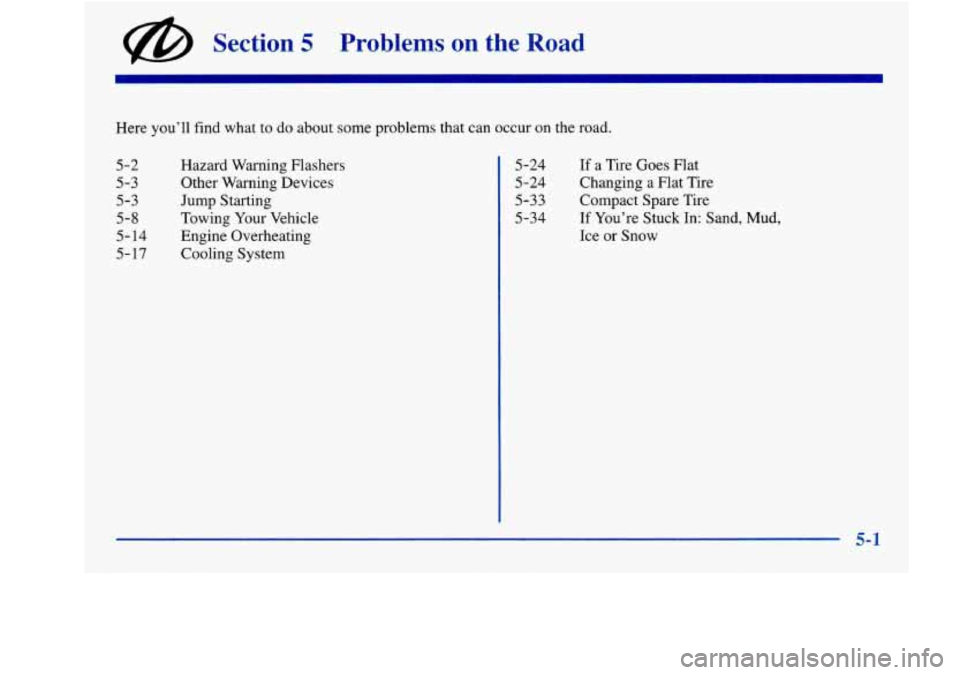
@ Section 5 Problems on the Road
Here you’ll find what to do about some problems that can occur on the road.
5-2
5-3
5-3
5-8
5- 14
5- 17 Hazard Warning
mashers
Other Warning Devices
Jump Starting
Towing Your Vehicle
Engine Overheating
Cooling System 5-24
5-24
5-33
5-34
If a Tire Goes Flat
Changing a Flat Tire
Compact Spare Tire
If You’re Stuck In: Sand,
Mud,
Ice or Snow
5-1
Page 219 of 380
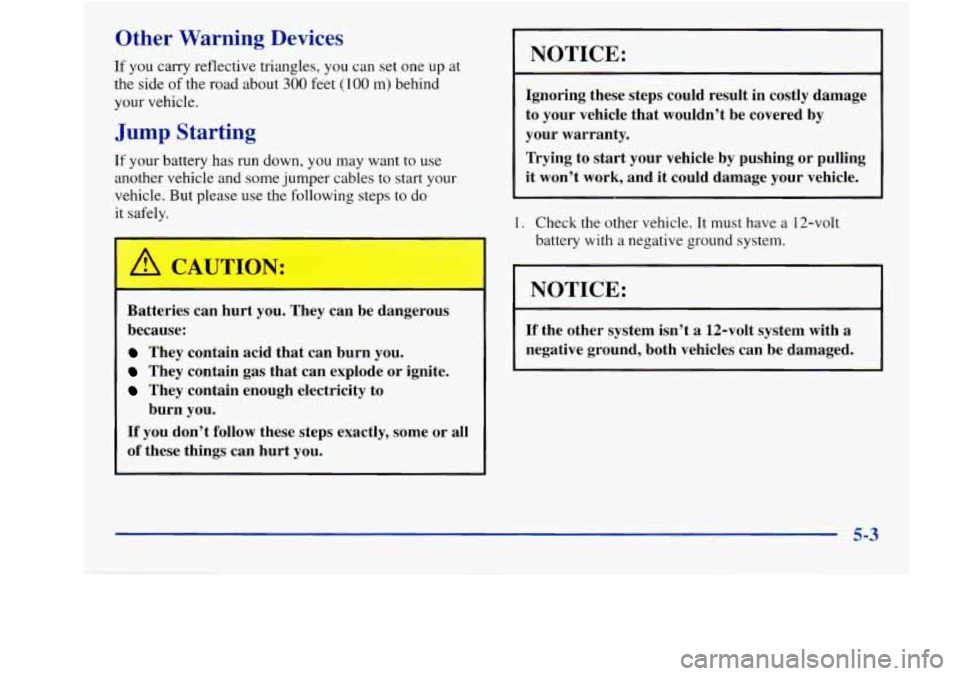
Other Warning Devices
If you carry reflective triangles, you can set one up at
the side of the road about
300 feet (1 00 m) behind
your vehicle.
Jump Starting
If your battery has run down, you may want to use
another vehicle and some jumper cables to start your
vehicle. But please use the following steps to do
it safely.
Batteries can hurt you. They can be dangerous
because:
They contain acid that can burn you.
They contain gas that can explode or ignite.
They contain enough electricity to
If you don’t follow these steps exactly, some or all
of these things can hurt you.
burn
you.
NOTICE:
Ignoring these steps could result in costly damage
to your vehicle that wouldn’t be covered by
your warranty.
Trying to start your vehicle by pushing or pulling
it won’t work, and it could damage your vehicle.
1. Check the other vehicle. It must have a 12-volt
battery with
a negative ground system.
NOTICE:
If the other system isn’t a 12-volt system with a
negative ground, both vehicles can be damaged.
5-3
Page 220 of 380
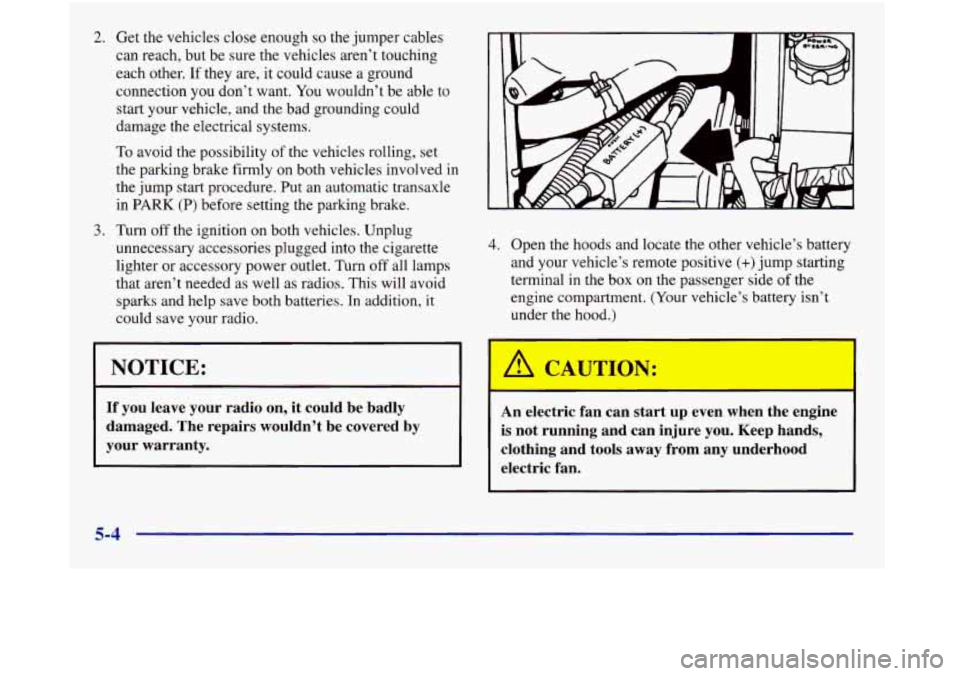
2. Get the vehicles close enough so the jumper cables
can reach, but be sure the vehicles aren’t touching
each other.
If they are, it could cause a ground
connection you don’t want. You wouldn’t be able to
start your vehicle, and the bad grounding could
damage the electrical systems.
To avoid the possibility of the vehicles rolling, set
the parking brake firmly on both vehicles involved in
the jump start procedure.
Put an automatic transaxle
in
PARK (P) before setting the parking brake.
3. Turn off the ignition on both vehicles. Unplug
unnecessary accessories plugged into the cigarette
lighter
or accessory power outlet. Turn off all lamps
that aren’t needed as well as radios. This will avoid
sparks and help save both batteries. In addition, it
could save your radio.
NOTICE:
If you leave your radio on, it could be badly
damaged. The repairs wouldn’t be covered by
your warranty.
4. Open the hoods and locate the other vehicle’s battery
and your vehicle’s remote positive (+)jump starting
terminal in the box on the passenger side
of the
engine compartment. (Your vehicle’s battery isn’t
under the hood.)
I
An electric fan can start up even when the engine
is not running and can injure you. Keep hands,
clothing and tools away from any underhood electric fan.
5-4
Page 283 of 380
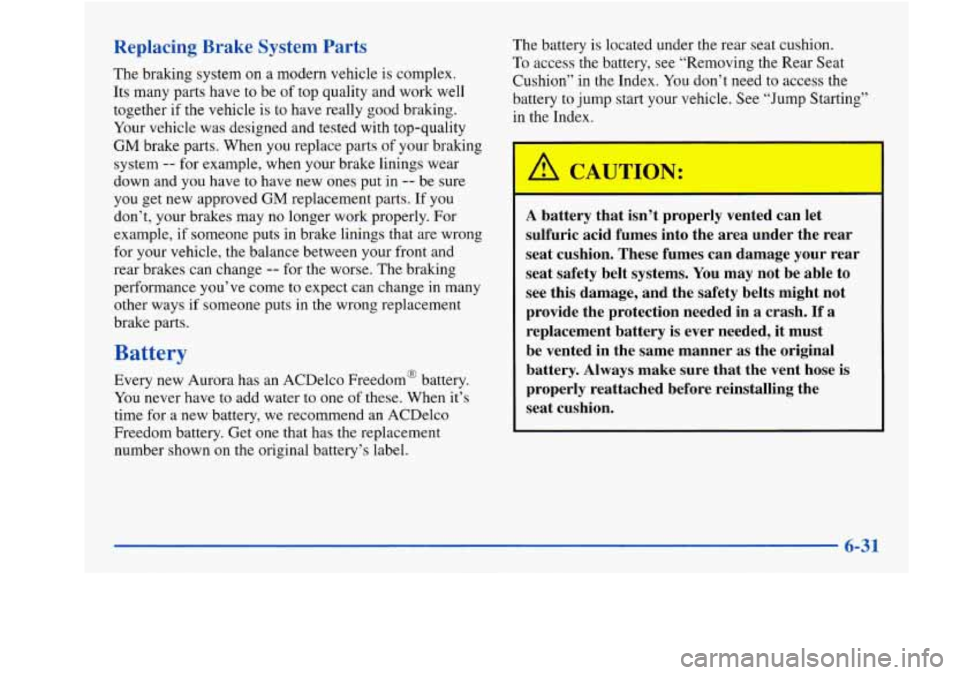
Replacing Brake System Parts
The braking system on a modern vehicle is complex.
Its many parts have to be of top quality and work well
together
if the vehicle is to have really good braking.
Your vehicle was designed and tested with top-quality
GM brake parts. When you replace parts of your bralung
system
-- for example, when your brake linings wear
down and you have
to have new ones put in -- be sure
you get new approved
GM replacement parts. If you
don’t, your brakes may no longer work properly. For
example, if someone puts in brake linings that are wrong
for your vehicle, the balance between your front and
rear brakes can change
-- for the worse. The braking
performance you’ve come to expect can change in many
other ways
if someone puts in the wrong replacement
brake parts.
Battery
Every new Aurora has an ACDelco Freedom@ battery.
You never have to add water to one of these. When it’s
time for a new battery, we recommend an ACDelco
Freedom battery. Get one that has the replacement
number shown on the original battery’s label. The
battery is located under the rear seat cushion.
To access
the battery, see “Removing the Rear Seat
Cushion” in the Index.
You don’t need to access the
battery to jump start your vehicle. See “Jump Starting”
in the Index.
A CAUTION:
A battery that isn’t properly vented can let
sulfuric acid fumes into the area under the rear
seat cushion. These fumes can damage your rear
seat safety belt systems. You may not be able to
see this damage, and the safety belts might not
provide the protection needed in a crash.
If a
replacement battery is ever needed, it must
be vented in the same manner as the original
battery.
Always make sure that the vent hose is
properly reattached before reinstalling the
seat cushion.
Page 284 of 380
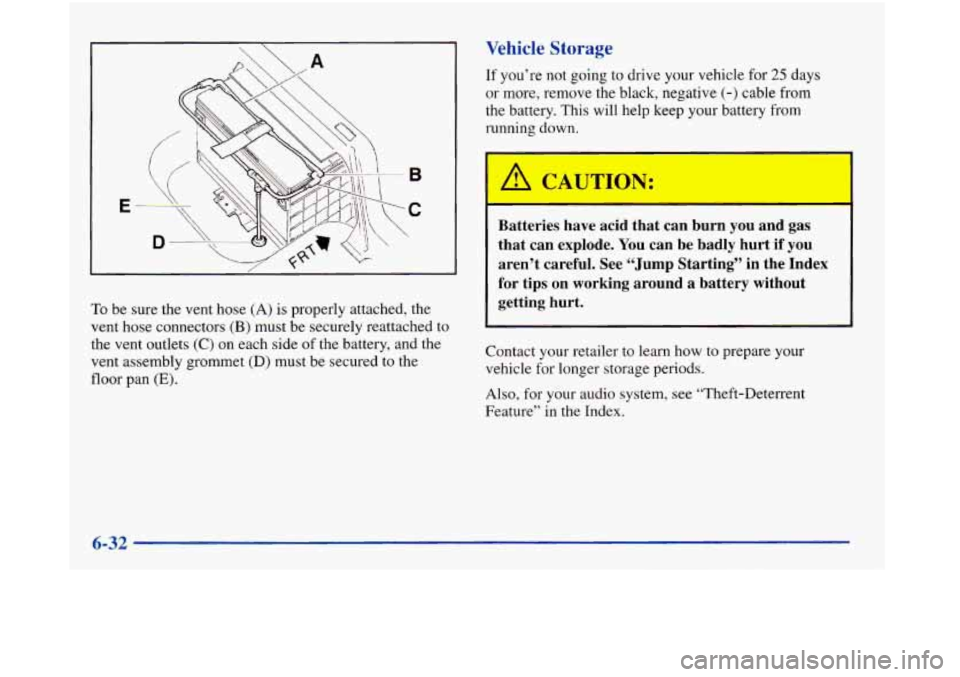
Vehicle Storage
If you’re not going to drive your vehicle for 25 days
or more, remove the black, negative
(-) cable from
the battery. This will help keep your battery from
running down.
To be sure the vent hose (A) is properly attached, the
vent hose connectors
(B) must be securely reattached to
the vent outlets
(C) on each side of the battery, and the
vent assembly grommet
(D) must be secured to the
floor pan
(E).
Batteries have acid that can burn you and gas
that can explode. You can be badly hurt if you
aren’t careful. See “Jump Starting” in the Index for tips on working around a battery without
getting hurt.
I I
Contact your retailer to learn how to prepare your
vehicle for longer storage periods.
Also, for your audio system, see “Theft-Deterrent
Feature’’ in the Index.
6-32
Page 363 of 380
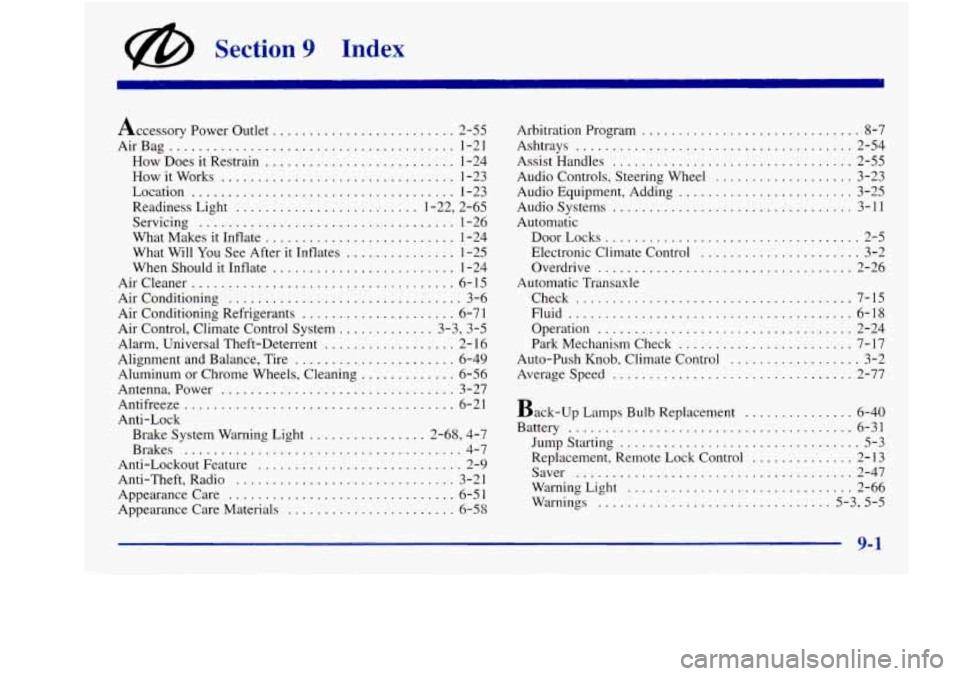
@ Section 9 Index
Accessory Power Outlet ......................... 2-55
Air Bag
....................................... 1-21
How Does
it Restrain .......................... 1-24
How it Works
................................ 1-23
Location
.................................... 1-23
Readiness Light
......................... 1.22, 2.65
Servicing
................................... 1-26
What Makes it Inflate
.......................... 1-24
What Will
You See After it Inflates ............... 1-25
When Should it Inflate
......................... 1-24
Aircleaner
.................................... 6-15
Air Conditioning ................................ 3-6
Air Control. Climate Control System
............. 3-3. 3-5
Alignment and Balance. Tire
...................... 6-49
Aluminum or Chrome Wheels. Cleaning
............. 6-56
Antenna. Power
................................ 3-27
Antifreeze
..................................... 6-2 1
Anti-Lock
Brake System Warning Light
................ 2-68. 4-7
Brakes
...................................... 4-7
Anti-Lockout Feature
............................ 2-9
Anti.Theft. Radio
.............................. 3-2 1
Appearance Care ............................... 6-5 1
Appearance Care Materials ....................... 6-53
Air
Conditioning Refrigerants
..................... 6-7 1
Alarm. Universal Theft-Deterrent .................. 2- 16 Arbitration Program
.............................. 8-7
Assist Handles
................................. 2-55
Audio Controls. Steering Wheel
................... 3-23
Audio Equipment. Adding
........................ 3-25
Audio Systems
................................. 3-11
Automatic DoorLocks
................................... 2-5
Electronic Climate Control
...................... 3-2
Overdrive
................................... 2-26
Check
...................................... 7-15
Fluid
....................................... 6-18
Operation
................................... 2-24
ParkMechanismCheck
........................ 7-17
Auto-Push Knob. Climate Control
.................. 3-2
Ashtrays
...................................... 2-54
Automatic Transaxle Averagespeed
................................. 2-77
Back-up Lamps Bulb Replacement
............... 6-40
Battery
....................................... 6-31
Jump Starting
................................. 5-3
Replacement. Remote Lock Control
.............. 2-13
Saver
...................................... 2-47
Warning Light
............................... 2-66
Warnings
................................ 5.3. 5.5
9-1
Page 368 of 380
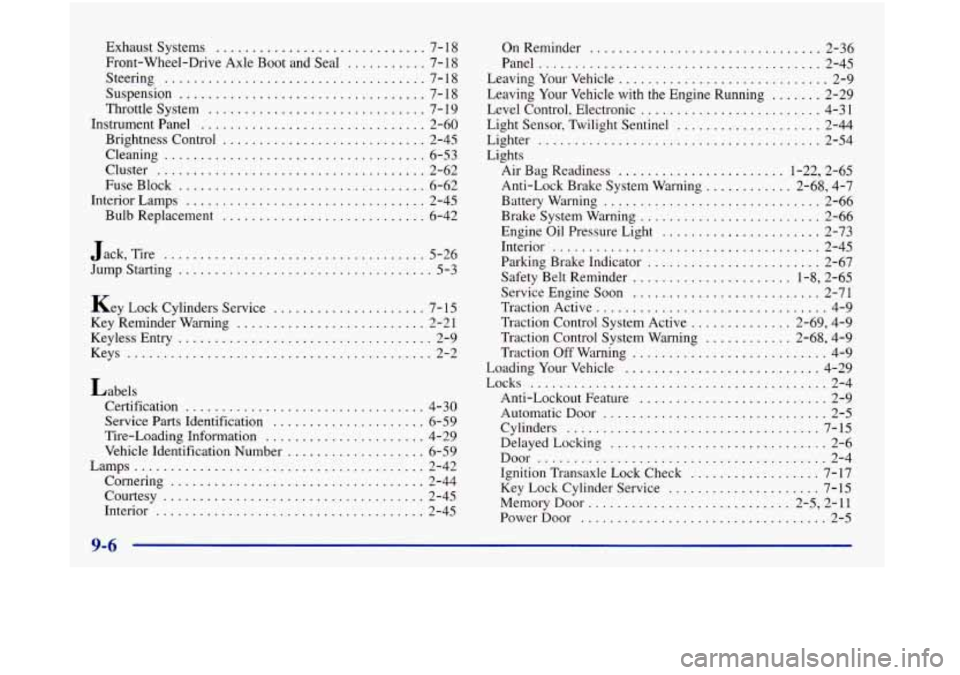
Exhaust Systems ............................. 7- 18
Front-Wheel-Drive Axle Boot and Seal
........... 7- 18
Steering
.................................... 7-18
Suspension
.................................. 7-18
Throttle System
.............................. 7- 19
InstrumentPanel ............................... 2-60
Brightness Control
............................ 2-45
Cleaning
.................................... 6-53
Cluster
..................................... 2-62
FuseBlock
.................................. 6-62
Interior Lamps
................................. 2-45
Bulb Replacement
............................ 6-42
.................................... J ack. Tire 5-26
Jump Starting
................................... 5-3
Key Lock Cylinders Service ..................... 7-15
Key Reminder Warning .......................... 2-21
Keyless Entry
................................... 2-9
Keys
.......................................... 2-2
Labels Certification
................................. 4-30
Service Parts Identification
..................... 6-59
Tire-Loading Information
...................... 4-29
Vehicle Identification Number
................... 6-59
Lamps
........................................ 2-42
Cornering
................................... 2-44
Courtesy
.................................... 2-45
Interior
..................................... 2-45 OnReminder
................................ 2-36
Panel
....................................... 2-45
Leaving Your Vehicle
............................. 2-9
Level Control. Electronic
......................... 4-31
Light Sensor. Twilight Sentinel
.................... 2-44
Lighter ....................................... 2-54
Lights Air Bag Readiness
....................... 1-22. 2-65
Battery Warning
.............................. 2-66
Brake System Warning
......................... 2-66
Engine Oil Pressure Light
...................... 2-73
Interior
..................................... 2-45
Parking Brake Indicator
........................ 2-67
Safety Belt Reminder
...................... 1.8. 2.65
Service Engine Soon
.......................... 2-71
Traction Active
................................ 4-9
Traction Control System Active
.............. 2.69. 4.9
Traction Off Warning
........................... 4-9
Loading Your Vehicle
........................... 4-29
Anti-Lockout Feature
.......................... 2-9
Automatic Door
............................... 2-5
Cylinders ................................... 7-15
DelayedLocking .............................. 2-6
Door
........................................ 2-4
Ignition Transaxle Lock Check
.................. 7-17
Key Lock Cylinder Service
..................... 7-15
Memory Door ............................ 2.5. 2.11
PowerDoor
.................................. 2-5
Leaving Your Vehicle with the Engine Running ....... 2-29
Anti-Lock Brake System Warning
............ 2.68. 4.7
Traction Control System Warning
............ 2.68. 4.9
Locks
......................................... 2-4